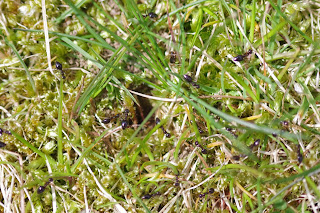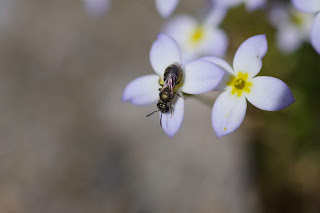So many delightful things in the backyard today! And by things, I mean bugs. It's not just that I saw a lot of bugs today–and I did see a lot of bugs today–but what I saw, and what the bugs were up to that was interesting.
Beginning with Backyard Bug of the Day:
Bee fly. Looks like a bee, but, you guessed it, it's a fly. No stinger, just pretending. It looks and flies like a bee. This may be the best picture I have ever taken of a bee fly. They flit from flower to flower, never staying still very long. I usually see only a couple every spring, so I was happy just to see one today. To get a decent picture was a very welcome bonus. Great way to start my bug walk.
Next interesting thing: The Forsythia Bush:
I found insects of several orders on the forsythia today, starting with this Coleoptera, a beetle, specifically a winter firefly, the pink of its pronotum hidden by pollen.
Here you can see pollination in action:
The bee rubs against the anther of the flower while delving inside to feed on nectar...
... and comes out covered in pollen, which it transfers to the next flower. Also, this is from the order Hymenoptera.
Lots of bugs on the forsythia today...
Not sure if this is a wasp, a fly, or a flying ant, but more on that later.
Tiny moth, order Lepidoptera. Which reminds me, I saw my first butterfly of the season today. A spring azure. I didn't have my camera at the time, and didn't get anywhere near close enough for a picture, but I saw it, and that was a lovely moment. Anyway, back to the forsythia...
Next order: Hemiptera:
Assassin bug. Because if you feed on bugs, a good place to hang out is on the plant where the other bugs are hanging out.
Stilt bug. Also Hemiptera, but it feeds by stabbing its stylet into the plant and sucking out liquids. It doesn't have to go into the flower and pollinate it.
The next interesting thing: Ant activities:
As I was walking along a backyard path I noticed a miniature commotion going on at my feet. There were a lot of bugs down on the ground, including several of these. Winged ant queens. So, here's what I think I know about ants: When the formicary/nest/community gets too crowded, several new queens will leave the nest to go out and start new ones. The queens are larger than the other ants, and have wings. But in preparation for this event other ants will grow wings, and they then swarm, hoping to mate with a queen to establish a new colony.
Winged queen, non-winged worker.
There were multiple queens crawling around.
Mate acquired.
Suddenly today there were bees everywhere. There were many in the rock garden, but all small and fast, aside from the bumblebees:
I did manage to get shots of sweat bees on some other flowers:
Birch catkin bug
All jumping spiders with prey today for Arachnid Appreciation:
.
.
.
.
.
.
.
.
.
.
.
.
This one is hiding its prey, but it had hold of something.
























No comments:
Post a Comment